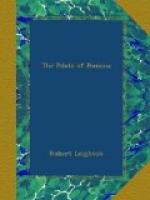Dropping the horrible thing upon the rock at his feet, where the rotten bone broke into fragments, he rushed out upon the beach and called us back. Attracted to the spot again, he watched the dog burrowing in the shingle. Amongst the stones and sand he saw the dull sheen of what he at first supposed was a curious seashell, but which, when he picked up and examined it, he found to be an old coin. Believing that there might be more of these buried in the sand, he went down upon his knees once more to search. He had just discovered the bar of metal when we returned.
“What is it?” he said. “Why, it’s silver?”
We each in turn handled the little bar, and expressed our opinion regarding what Hercus supposed it to be. It was heavy enough, certainly, to be silver; but the improbability of such a piece of the precious metal being left there presented itself, and none of us was quite satisfied until Hercus, taking out his knife, cut and scraped the surface of the ingot and revealed the shining white metal underlying the grit and tarnish that had gathered upon it during the years—perhaps the centuries—it had lain there undisturbed.
By our united efforts we enlarged the hole that Willie and the dog had made, digging with the harpoon and removing with our hands the loosened stones. We found a quantity of antique coins of various sizes, which, by reason of their lightness, I suppose, were much scattered about. Then deeper down below these we came upon a number of large rings, or bracelets, in the form of horseshoes, and several ingots of silver, similar to the one Hercus had first found.
We grew excited in our search; and as the quantity of treasure we unearthed increased, so did we increase our exertions, until there was quite a heap of silver gathered upon the slab of flagstone where we placed it.
At a spot near where Hercus had discovered the skull we found a curious garment, formed of a fine network of rings and chains. It was much broken and torn—though the shoulder bands were preserved, as well as the collar—and we could see that the owner, whoever he might have been, must have had a large and strong body, for the coat was of great weight. Beside it there were what we took to be the remains of a helmet, the ornaments upon which were of a yellow and still untarnished metal, with a large crimson stone set in the front.
Hercus pronounced the metal to be brass; but I never discovered truly what it was, as I did not handle the fragments again, for the reason that (as I happened to notice at the time) Tom Kinlay, who kept silence regarding them, quietly put them in his pocket, allowing us afterwards to suppose that we had left them behind us. I had my suspicions, however, that the ornaments were of pure gold.
In addition to the coat of mail and the helmet, there were three other objects that engaged our special regard. These were a broken belt—made of link rings of bronze—the head of a battle axe, and a long sword. The sword, which was in a scabbard embossed with fine ornaments, had a richly-figured handle. It was a heavy weapon, and none of us could draw it from its scabbard, for the rust that encrusted it.




